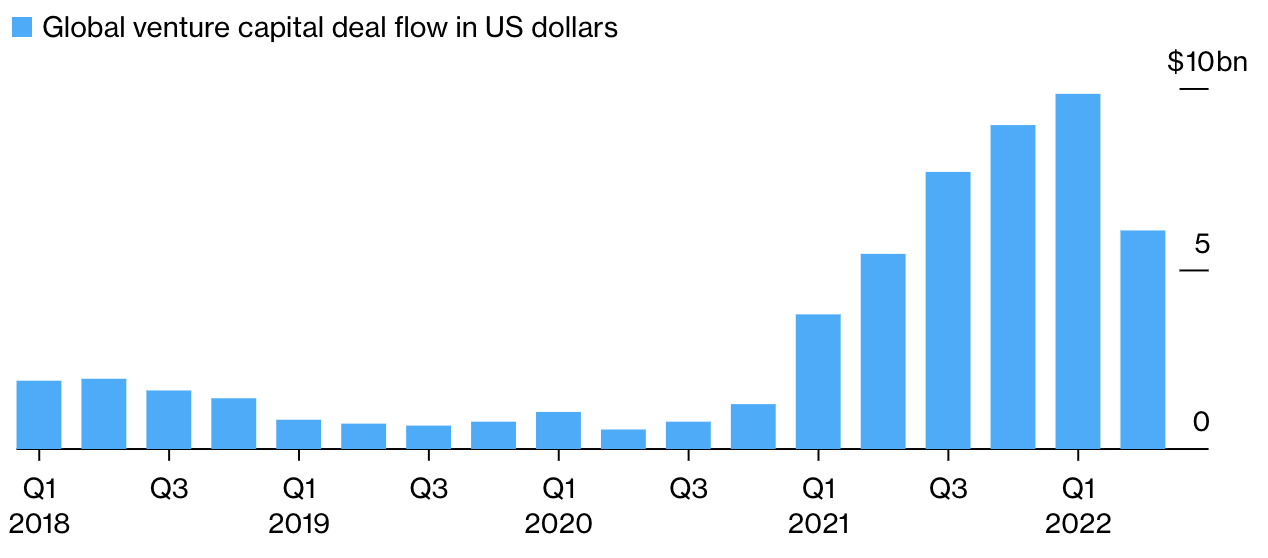Issue 165: A New GBP-pegged Stablecoin, FTX Making Chess Moves, and More!
.webp)


This Week in Crypto
Markets are doing slightly better than the last 7 days; the crypto market gained 11% capitalization, with Bitcoin jumping 4.7% and Ethereum 9.4% since last Tuesday. The market sentiment is kept at the edge of its seat as speculators compare the liquidity crisis accumulating on the likes of BlockFi, Celsius, and other DeFi platforms to the financial crisis in 2008. On the brighter side of the tunnel, Bank of England’s Deputy Governor Jon Cunliffe said that crypto projects that survive these trying times in the industry could become the tech companies of the future; aligning with other bullish sentiments that deem the market crash as healthy to infiltrate the strong projects from the weaklings.
Figure 1: More VC Money in Digital Assets since Last Market Crash

Source: PitchBook, Bloomberg
Key Takeaways
- Cardano lobbies for software-enabled self-regulation for the cryptoassets industry
- Data indicates nearing a market bottom
- Tether to launch GBP-pegged stablecoin
- KPMG kicks off collaboration hub in the metaverse
- Solana unveils web3-focused Android phone
Macro, Regulations; Spot, and Derivatives Markets
Former UK Chancellor Philip Hammond expressed his concerns about the Kingdom’s progress with crypto regulations. Working as a senior advisor to Copper.co, Hammond explained that Brexit, COVID-19, and their repercussions could be the main drivers of this lag. However, Hammond recommends that the Financial Conduct Authority needs to consult with the crypto industry to hire the talents required to work up the regimes the UK needs to introduce. On that note, British MP Matt Hancock reiterated the importance of having a “liberal” regulatory framework for cryptoassets. Hancock is taking it upon himself to position the UK as the jurisdiction of choice for crypto.
In the US, Chairman of the Securities and Exchange Commission (SEC) Gary Gensler is lobbying for one rule book on crypto exchanges that would protect all trading regardless of the pair. If a token that represents a commodity is listed on a platform overseen by the SEC, the securities regulator would send that information over to the CFTC, which oversees commodities. However, there’s a bill that somewhat challenges Gensler’s lobbying and expands the CFTC’s oversight over the industry. Senator Cynthia Lummis posted the bill on Github for public feedback.
Cardano’s co-founder Charles Hoskinson explained to Congress why software-enabled self-regulation for the cryptoassets industry makes sense. Similar to private banking self-regulation works, Hoskinson suggested that the industry could create a “self-certification system” that could automatically monitor compliance until an anomaly is encountered, at which point a financial authority would review it. Furthermore, being able to store and transfer data gives cryptocurrencies the jurisdiction to carry out much of this regulatory work in an automated manner.
On-chain Indicators
Historically speaking, miner capitulation has served as an indication that the Bitcoin market is close to finding a bottom. Increasingly tumbling prices cause miners to not only turn off their mining facilities but also forces them to dispose of their BTC holdings in order to cover their operational expenses.
One useful metric that helps in contextualizing this event is the Hash Ribbons Indicator, which calculates the changes in Bitcoin’s hash rate to assess the likability of a capitulation event. A bearish crossover of the 30-day moving average below the 60 MA visualizes this development. Based on the chart below, miners have entered this capitulation area since the 7th of June
Figure 2: Bitcoin Hash Ribbons Indicator

Source: Glassnode
Data coming out of mining-focused public companies confirms this pivoting thesis as well. For instance, Bitfarms - running one of the largest mining firms in North America - has adjusted its HODLing strategy by selling half its BTC stack to cover debt, and will put its expansion plans on hold for the foreseeable future. The adverse impact of the market isn’t just limited to Bitfarms, as in fact, public-listed mining companies have sold roughly 30% of their Bitcoin production positions throughout May.
DeFi
The lead story that spelt some unease for Ethereum and its complementary L2 ecosystem had been the news of the order-book-based DEX DyDx protocol’s planned migration to Cosmos. The move should see the largest perpetual trading platform by volume pivot from utilizing the scalable starkware infrastructure into launching its own layer 1 blockchain on top of the cosmos network. The rationale behind the decision was fueled by DyDx’s intent on fully decentralizing the protocol, a notion that might be incompatible with Starkware as the solution relies on centralized sequencers, which could put it at crosshairs of legal scrutiny. The current limitations on the L2’s throughput are another reason why DyDx opted for this decision. Even though the move shouldn’t discredit the progress and growth happening within the L2 vertical, it does draw attention to the significance of app-specific chains and their practicality for specific use cases that might not postulate the same security and scalability requirements found in L2 solutions.
Within the stablecoins vertical, Tether disclosed they will be releasing a new stablecoin pegged to British Pound Sterling in early July, $GBP₮. The newly issued token should adopt the same technical and collateral design of the US-dollar backed USDT, as well as the Euro, Mexican-Peso and yuan-pegged stablecoins. In other news, researchers at Russia's government-owned institute of research and Expertise have advocated for the creation of a gold-backed stablecoin that could assist the country in evading sanctions. The move would help Russia offload the reserves of its commodity in OTC deals that would make it harder to track with ‘friendlier’ countries.
NFTs, Metaverse, and DAOs
In light of the current market conditions, projects are pushing their launches until the market stabilizes; leaving their airdrop holders disappointed. This gives birth to a new non-fungible innovation. Similar to futures contracts, non-fungible airdrops (NFA) would represent the true value of an airdrop reward when an initial DEX offering happens, however, the project owner would be the one promising to deliver the token or other digital assets on a future launch date.
In the empire of NFT games, Axie Infinity will be compensating its users who fell victim to the Ronin bridge exploit, which amounted to $620M in losses back in March, but after they relaunch the bridge. Each user will be able to withdraw an ETH for each one they owned before the attack.
Last week saw funds and acquisitions in the NFTs market, which include:
- Solana’s NFT marketplace Magic Eden raised $130M at a $1.6B valuation.
- Uniswap Labs acquired NFT marketplace aggregator Genie.
- eBay acquired NFT marketplace KnownOrigin.
- Gucci invests $25K worth of RARE in SuperRare DAO to start Digital Art Vault.
One of the Big Four accounting companies, KPMG, is launching a collaboration hub in the metaverse to help its clients to develop strategies in that space. In a new trend dubbed “tokengated” commerce, e-commerce platform Shopify is hoping to gain customer loyalty by allowing merchants to add utility to NFTs. Other indicators of adoption that happened last week include:
- American rapper Pharrell Williams was appointed as Chief Brand Officer of the NFT collection, Doodles, which is also preparing to launch a new edition.
- Cristiano Ronaldo and Binance team up for an NFT partnership.
- Eminem and Snoop Dogg made a Bored Ape Yacht Club music video.
- Bentley Motors announced they’ll launch NFTs on Polygon.
Crypto Infrastructure
Solana stole the spotlight as they announced they will be releasing a web3-focused Android phone. The device will embrace competitive features that puts it on par with high-end Samsung and Apple phones by featuring 12GBs of RAM and 512 GB disk capacity. However, it is the software layer dubbed SMS (Solana Mobile Stack) running on top of the OS that will introduce new vital features indispensable for accelerating user adoption. Innovations will include a seed-vault, dedicated app-store-like for native applications, and an integration with Solana-pay. Device is scheduled for a release in Q1 of next year.
On the other hand, Avalanche released their long-anticipated bridging support for the Bitcoin network. The feature baked into their core wallet will help introduce BTC to the growing DeFi ecosystem on the growing blockchain without encountering much of the previous design-trust issues present in WBTC. Concurrently, Ethereum also received its fair share of attention last week as the POS beacon chain was deployed on the Sepolia testnet. The event is a significant step toward the merge as it facilitates a dress rehearsal for developers implementing the network upgrade which is crucial to ensure the smooth operability of the merge. All the previous testnets - Rikneby, Ropsten and Kiln - will be eventually deprecated in favor of focusing on Sepolia.
When it comes to smart-contract hacks, the Harmony one cross-chain bridge dubbed Horizon, linking to the Ethereum network, was exploited for a total amount of $100M. The network’s foundation team has halted the affected bridge and reached out to forensics companies like Elliptic in order to identify the perpetrator and retrieve the stolen funds. Over a billion dollars have already been siphoned out of vulnerable bridges so far this year.
Weekly Returns
The returns of the top five cryptoassets over the last week were as follows — BTC (1.7%), ETH (6.8%), BNB (6.86%), ADA(2.59%), XRP (9.39%)

Media Coverage
Our CEO and co-founder Hany Rashwan went live on CoinDesk TV on Monday to discuss market conditions. “As an ETF provider, we had the ability to create a number of new shares, as new investors come in, we’re in an all-time high in terms of number of shares, now the prices have obviously depressed but that shows an incredible amount of new investors and inflows,” Hany told CoinDesk TV. You can watch the full segment here.
On another note, 21Shares’ co-founder and president Ophelia Snyder got featured on Bein Crypto. The article reads: Many larger firms may also lack the technical expertise necessary to confidently deal with crypto assets. "The level of technical detail you need is quite high," said Ophelia. "That reality disproportionately benefits specialized firms."
Last but not least, our last newsletter was featured on Finanzen.ch and Bond Guide in German. If you want to switch to the German newsletter, click here.
News - Morgan Creek Digital and FTX Compete Over Acquiring Crypto Lender BlockFi
What happened?
On June 21st, BlockFi’s CEO Zac Prince announced on Twitter that his company signed a term sheet with FTX to secure a $250M revolving credit facility to provide access to capital that further bolsters the crypto lender’s balance sheet and platform strength. The proceeds of the credit facility were intended to be contractually subordinate to all client balances across all account types (BIA, BPY and loan collateral) and will be used as needed.
Three days later, news circulated that FTX in talks to acquire stake in BlockFi, nudging cryptocurrency investment firm Morgan Creek Digital to roll up its sleeves and raise $250M from investors to purchase a majority stake in crypto lender.
Why does it matter?
The downfall of prices that took a sharp turn in May had a domino effect on crypto exchanges and DeFi platform, namely BlockFi, which lost almost 80% of its valuation. There are four reasons this story matters:
- The credit line agreement gives FTX the option to buy BlockFi at allegedly zero price.
- This would effectively wipe out all of BlockFi’s existing equity shareholders, including management and employees with stock options, as well as all equity investors in the company’s previous venture rounds.
- However, FTX’s agreement was the only emergency financing option offered to BlockFi that would not subordinate client assets to the rescuer.
- Unless BlockFi went with FTX, its depositors would have had to wait in line behind the new lender to be repaid.
This is a further testament that the bear market is a battleground to test crypto projects in the space and thicken the skin of those who remain. The $250M revolving credit facility sets an example for bigger crypto companies to collaborate with younger projects to enhance accessibility of crypto markets.
Now with Morgan Creek wanting in on the deal, the trend is crystal clear that extreme market conditions have tempted companies to help younger projects amid times of fear, uncertainty, and doubt, while also getting in on the benefits that would be collected in the not-so-near future.
Disclaimer
The information provided does not constitute a prospectus or other offering material and does not contain or constitute an offer to sell or a solicitation of any offer to buy securities in any jurisdiction. Some of the information published herein may contain forward-looking statements. Readers are cautioned that any such forward-looking statements are not guarantees of future performance and involve risks and uncertainties and that actual results may differ materially from those in the forward-looking statements as a result of various factors. The information contained herein may not be considered as economic, legal, tax or other advice and users are cautioned to base investment decisions or other decisions solely on the content hereof.









_logo.svg)

.svg.png)